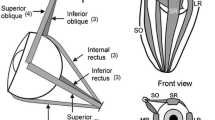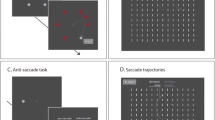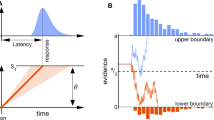Abstract
There are a number of statements that can be made about eye movements of monkeys during the learning of simple and complex discriminative problems that are probably applicable to a wide variety of visual tasks. There are systematic changes in eye movements as a function of practice. Some of these changes occur long after grosser measures of performance, such as frequency of correct choices, have reached an asymptote. Hence, short-term studies of visual information processing may be misleading. Duration of visual fixations and frequency of visual fixations are independent measures, reflecting different cognitive processes. Studies which measure only total looking time confound these two measures and, thus, may miss important information. Eye movements appear to be an important, if not essential, component of the chain of events constituting the cognitive processing underlying performance on visual tasks.
Similar content being viewed by others
References
Geary, N. D., and Schrier, A. M. (1975). Eye movements of monkeys during performance of ambiguous cue problems.Anim. Learn. Behav. 3: 167–171.
Rayner, K. (1978). Eye movements in reading and information processing.Psychol. Bull. 85:618–660.
Schrier, A. M., and Povar, M. L. (1978). Eye movements of monkeys during learning set formation.Science 199: 1363–1364.
Schrier, A. M., and Povar, M. L. (1979). Eye movements of stumptailed monkeys during discrimination learning: VTE revisited.Anim. Learn. Behav. 7: 239–245.
Schrier, A. M., and Povar, M. L. (1982). Eye movements of monkeys during discrimination learning: Role of visual scanning.J. Exp. Psychol. Anim. Behav. Proc. 8: 33–48.
Schrier, A. M., and Vaughan, J. (1973). Eye movements of monkeys during learning of color and form discrimination problems involving reversal and nonreversal shifts.Primates 14: 161–178.
Schrier, A. M., and Wing, T. G. (1973). Eye movements of monkeys during brightness discrimination and discrimination reversal.Anim. Learn. Behav. 1:145–150.
Schrier, A. M., Povar, M. L., and Vaughan, J. (1970). Measurement of eye orientation of monkeys during visual discrimination.Behav. Res. Meth. Instrument. 2: 55–62.
Senders, J. W., Fisher, D. F., and Monty, R. A. (1978).Eye Movements and the Higher Psychological Processes, Erlbaum, Hillsdale, N.J.
Vaughan, J. (1975) On-line, real-time recording of eye orientation using the corneal reflection method.Behav. Res. Meth. Instrument. 7: 211–214.
Author information
Authors and Affiliations
Rights and permissions
About this article
Cite this article
Schrier, A.M. Eye movements of stumptailed monkeys during discriminative performance: An overview. Int J Primatol 4, 373–381 (1983). https://doi.org/10.1007/BF02735600
Received:
Revised:
Issue Date:
DOI: https://doi.org/10.1007/BF02735600




